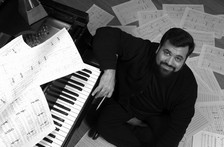
Nickitas Demos (1962, USA) holds a Doctor of Musical Arts degree in Composition from the Cleveland Institute of Music and Case Western Reserve University where he studied with Donald Erb. He also holds a Master of Music degree in composition from the Indiana University Jacobs School of Music where he studied with Donald Erb, Eugene O’Brien, Harvey Sollberger, and John Eaton. He received a Bachelor of Music degree in clarinet performance from the University of North Carolina at Chapel Hill where he studied composition with Roger Hannay.
Orhestras which have performed his works include the Cleveland Orchestra, Philadelphia Orchestra, Orchestra of St. Luke’s, Nashville Chamber Orchestra, Nashville Symphony, Cincinnati Symphony Orchestra, Colorado Springs Symphony, Oregon Symphony and the New World Symphony among others. His works for wind ensembles have been performed by the U.S. Army Band, Pershing’s Own and the Conservatorio de Música de Puerto Rico Symphonic Band among others. North/South Consonance, Thamyris New Music Ensemble, Bent Frequency, the Atlanta Chamber Players and the neoPhonia New Music Ensemble among others have performed his chamber works. His commissions include works for the Cleveland Orchestra, Nashville Chamber Orchestra, Atlanta Community Orchestra, the Atlanta Chamber Players and the Georgia Music Teachers Association.
He is the recipient of numerous grants and awards including Grand Prize in the 2004 Millennium Arts International Competition for Composers, Grand Prize in the 2005 Holyoke Civic Symphony Composition Competition, U.S. Birmingham & Atlanta Prizes in the Hultgren 2005 Solo Cello Works Biennial Composition Competition and eleven ASCAP Awards among others.
Demos’ works have been programmed at festivals, symposia and conferences including the 43rd Dimitria Festival (Thessaloniki, Greece); International Festival – Institute at Round Top (TX); the Ernest Bloch Music Festival (Newport, OR): the New Music Forum Festival of Contemporary Music (San Francisco, CA); the Annual New Music & Art Festival (Bowling Green State University); the Biennial Festival of New Music (Florida State University) and at National and Regional Meetings of the College Music Society and the Society of Composers, Inc. His music is published by MMB Music, Inc., recorded on the MSR Classics label, Capstone Records and has also been broadcast on WABE-FM 90.1 (Atlanta NPR affiliate), Georgia Public Radio and Internet Radio sites such as the American Music Center’s CounterStream among others.
Demos currently holds the positions of Associate Professor of Composition and Coordinator of Composition Studies at the Georgia State University School of Music. He is also the Founder and Artistic Director of the neoPhonía New Music Ensemble, the Director of the Center for Hellenic Studies in the College of Arts & Sciences and holder of the Andrew C. and Eula C. Family Founding Chair in Contemporary Greek Studies. Outside of his work at Georgia State University, he currently serves on the Executive Committee of the Society of Composers, Inc. (SCI) and was a Co-Founder of Bent Frequency, a professional contemporary music ensemble based in Atlanta, where he served as Composer-In-Residence and member of the Art Council from 2003-2008. He also serves as the Musical Director for the Greek Islanders, an ethnic ensemble he founded in 1982 specializing in Greek folk music.
intelligent designs (2009), string trio & animated film
Dedicated to Musica Da Camera: Helen Kim, violin; Tania Maxwell Clements, viola; and Charae Krueger, cello.
Although a stand alone piece in its own right, intelligent designs was written to accompany an animated film created by Joe Peragine, an artist and professor at the Ernest G. Welch School of Art and Design at Georgia State University. The film depicts abstracted scenes of the creation of the universe moving swiftly from a “big bang” event through the unfolding of life on the earth. Throughout, images of the periodic chart and various formulas as well as vivid images of a super collider (a large mechanism constructed to force atoms to crash into one another and thus creating small “big bangs” and potential black holes for scientific study) are interspersed. The animation takes place on two large screens with independent images and events shown on each respective screen.
The music tracks along with the formal design of the film; reacting to and commenting upon the images presented. The violin is linked to the imagery and events on one screen while the viola is linked to those on the other screen. The central figure of the cello acts as both a collaborator and commentator on the actions of the others. The opening and closing of the piece feature two related cello solos that frame the work. The entire piece (both film and music) is divided into three main sections: an opening star field that ends with a supernova event; a series of imagery depicting the super-collider, periodic tables, formulas and various abstract images; and finally, a series of images depicting the evolutionary development of life on the planet all concluding with a rapid retrograde of all the images collapsing in on themselves. In the opening section, there is a conscious homage to Ives’s Unanswered Question with the cello in the role of the solo trumpet voice of that work.
However, the cello, for me, becomes much more than simply a questioner looking towards an empty sky. The cello voice fulfills several functions. However, it is chiefly a conversation between Man and God on a certain level. It poses initial questions, but also collaborates with the other two voices in much the same way as humanity acts in a co-creative way with God on Earth. The cello also features a small fragment from an ancient Byzantine chant melody (Agios O Theos – HolyGod) which represents an answer to the question and is constantly working behind the visible scenes.
The composition and film were made possible in part through a grant from the Center for Collaborative and International Arts (CENCIA) at the College of Arts & Sciences, Georgia State University.


